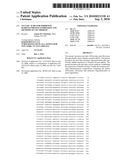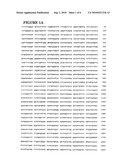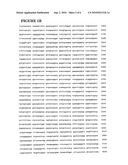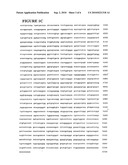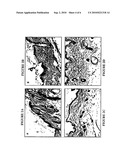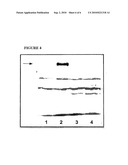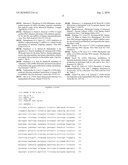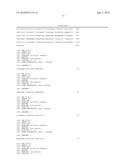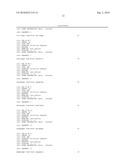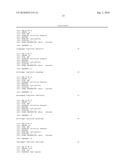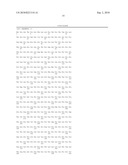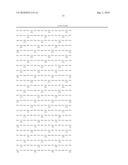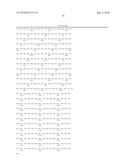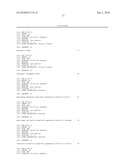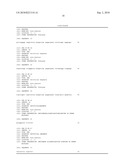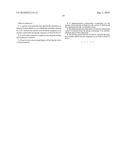Patent application title: NUCLEIC ACIDS FOR INHIBITING HAIRLESS PROTEIN EXPRESSION AND METHODS OF USE THEREOF
Inventors:
Angela M. Christiano (West Orange, NJ, US)
IPC8 Class: AA61K9127FI
USPC Class:
424450
Class name: Drug, bio-affecting and body treating compositions preparations characterized by special physical form liposomes
Publication date: 2010-09-02
Patent application number: 20100221318
Claims:
1. A nucleic acid molecule that specifically hybridizes to Hairless
Protein mRNA so as to inhibit the translation thereof in a cell, wherein
the nucleic acid molecule comprises consecutive nucleotides having the
sequence of SEQ ID NO:27.
2. A vector that comprises a sequence encoding the nucleic acid molecule of claim 1.
3. A host-vector system comprising a cell having the vector of claim 2 therein.
4. A pharmaceutical composition comprising (a) the nucleic acid molecule of claim 1 or the vector of claim 2 and (b) a pharmaceutically acceptable carrier.
5. The pharmaceutical composition of claim 4, wherein the carrier is selected from the group consisting of an alcohol, ethylene glycol and a liposome.
6. The nucleic acid molecule of claim 1, wherein the Hairless Protein mRNA has the sequence as set forth in SEQ ID NO:1.
Description:
CROSS-REFERENCE TO RELATED APPLICATIONS
[0001]This application is a divisional of U.S. patent application Ser. No. 12/139,818 filed Jun. 16, 2008, which is a continuation of copending U.S. patent application Ser. No. 10/122,013 filed Apr. 12, 2002, which claims the benefit of priority of U.S. Provisional Application No. 60/283,618 filed Apr. 13, 2001, the contents of each of which are hereby incorporated by reference in their entirety.
BACKGROUND OF THE INVENTION
The Hairless Gene
[0002]The hairless mouse, a frequent subject of different dermatological experiments, is characterized by hair loss that starts at the age of 14 days postpartum from the upper eyelids and progresses caudally. The process is completed by the age of 3 weeks, when the mice are entirely naked and never grow hair again (Panteleyev et al. 1998b). The phenotype results from proviral integration and consequential aberrant splicing in the mouse hairless gene. Lack of expression of the mouse hairless gene due to inherited mutations leads to the complete loss of hair, known as atrichia. Other mutations have been identified in other mouse hairless alleles, and its human equivalent, resulting in essentially similar phenotypes (Ahmad et al. 1998a; Ahmad et al. 1998b; Panteleyev et al. 1998a). Those studies demonstrated that hairless expression in the hair follicle is necessary for hair cycling, specifically in the transition to the catagen phase.
Catalytic Nucleic Acid Molecules
[0003]Gene therapy is perhaps the most exciting promise of modern medical science. The technology of replacing mutant genes with correct ones can provide definitive therapy for a number of diseases. There are, however, conditions--inherited and acquired alike--which cannot be treated by the introduction of a new gene. In many cases, the ablation of an already existing gene may be desirable. In many dominantly inherited diseases, the successful "knock-out" of the mutant gene is, in theory, sufficient to cure the disease. In some other cases, the elimination of a normally functioning, wild-type gene may be necessary for therapeutic gene targeting.
[0004]Such is the case in abundant hair growth or hirsutism, in which inhibiting genes which promote hair growth could lead to decreased hair growth and, therefore, improvement. One way to achieve targeted, transient gene suppression is likely going to be through the use of catalytic nucleic acid technology, which includes both ribozymes and DNAzymes.
[0005]Ribozymes are RNA structures having a self-catalytic enzymatic function which, together with their sequence-specific and RNA-binding ability, make them capable of cleaving other RNA molecules at specific target sequences (Cech 1987). Recent success has been achieved in engineering ribozymes capable of selectively recognizing target sequences carrying different types of mutations, including single base-pair missense mutations (Parthasarathy et al. 1999; Sioud and Drlica 1991; Vaish et al. 1998).
[0006]These encouraging achievements give new perspective to experimental strategies using selective mRNA ablation (Phylactou et al. 1998). The different groups of ribozymes described thus far (including hairpin ribozymes, hammerhead ribozymes and group I intron ribozymes (Bartel 1999)) have different characteristics with respect to their mechanism of splicing, splicing efficiency and target specificity. Several studies have used hammerhead ribozymes to selectively cleave RNA because of the superior target specificity of these ribozymes (Long and Sullenger 1999; Phylactou et al. 1998; Vaish et al. 1998).
[0007]Ribozymes can be delivered exogenously, such that the ribozymes are synthesized in vitro. They are usually administered using carrier molecules (Sioud 1996) or without carriers, using ribozymes specially modified to be nuclease-resistant (Flory et al. 1996). The other method is endogenous delivery, in which the ribozymes are inserted into a vector (usually a retroviral vector) which is then used to transfect target cells. There are several possible cassette constructs to chose from (Vaish et al. 1998), including the widely used U1 snRNA expression cassette, which proved to be efficient in nuclear expression of hammerhead ribozymes in various experiments (Bertrand et al. 1997; Michienzi et al. 1996; Montgomery and Dietz 1997).
[0008]Recent efforts have led to the successful development of small DNA oligonucleotides that have a structure similar to the hammerhead ribozyme (Santoro and Joyce 1997). These molecules are known as "deoxy-ribozymes", "deoxyribozymes" and "DNAzymes", and are virtually DNA equivalents of the hammerhead ribozymes. They consist of a 15 by catalytic core and two sequence-specific arms with a typical length of 5-13 by each (Santoro and Joyce 1998). Deoxy-ribozymes have more lenient consensus cleavage site requirements than hammerhead ribozymes, and are less likely to degrade when used for in vivo applications. The most widely used type of these novel catalytic molecules is known as the "10-23" deoxy-ribozyme, whose designation originates from the numbering used by its developers (Santoro and Joyce 1997). Because of their considerable advantages, deoxy-ribozymes have already been used in a wide spectrum of in vitro and in vivo applications (Cairns et al. 2000; Santiago et al. 1999).
SUMMARY OF THE INVENTION
[0009]This invention provides a catalytic deoxyribonucleic acid molecule that specifically cleaves Hairless Protein mRNA comprising: [0010](a) a catalytic domain that cleaves mRNA at a defined consensus sequence; [0011](b) a binding domain contiguous with the 5' end of the catalytic domain; and [0012](c) a binding domain contiguous with the 3' end of the catalytic domain,
[0013]wherein the binding domains are complementary to, and therefore hybridize with, the two regions flanking the defined consensus sequence within the Hairless Protein mRNA at which cleavage is desired, and wherein each binding domain is at least 4 residues in length, and both binding domains have a combined total length of at least 8 residues.
[0014]This invention also provides a catalytic ribonucleic acid molecule that specifically cleaves Hairless Protein mRNA comprising: [0015](a) a catalytic domain that cleaves mRNA at a defined consensus sequence; [0016](b) a binding domain contiguous with the 5' end of the catalytic domain; and [0017](c) a binding domain contiguous with the 3' end of the catalytic domain,
[0018]wherein the binding domains are complementary to, and therefore hybridize with, the two regions flanking the defined consensus sequence within the Hairless Protein mRNA at which cleavage is desired, and wherein each binding domain is at least 4 residues in length, and both binding domains have a combined total length of at least 8 residues.
[0019]This invention also provides a first pharmaceutical composition comprising the instant catalytic ribonucleic acid molecule or deoxyribonucleic acid molecule and a pharmaceutically acceptable carrier.
[0020]This invention further provides a method of specifically cleaving Hairless Protein mRNA comprising contacting the mRNA with either of the instant catalytic nucleic acid molecules under conditions permitting the molecule to cleave the mRNA.
[0021]This invention further provides a method of specifically cleaving Hairless Protein mRNA in a cell, comprising contacting the cell containing the mRNA with either of the instant catalytic nucleic acid molecules so as to specifically cleave the hairless protein mRNA in the cell.
[0022]This invention further provides a method of specifically inhibiting the expression of Hairless Protein in a cell that would otherwise express Hairless Protein, comprising contacting the cell with either of the instant catalytic nucleic acid molecules so as to specifically inhibit the expression of Hairless Protein in the cell.
[0023]This invention further provides a method of specifically inhibiting the expression of Hairless Protein in a subject's cells comprising administering to the subject an amount of either of the instant catalytic nucleic acid molecules effective to specifically inhibit the expression of Hairless Protein in the subject's cells.
[0024]This invention further provides a method of specifically inhibiting the expression of Hairless Protein in a subject's cells comprising administering to the subject an amount of the first pharmaceutical composition effective to specifically inhibit the expression of Hairless Protein in the subject's cells.
[0025]This invention further provides a method of inhibiting hair production by a hair-producing cell comprising contacting the cell with an effective amount of either of the instant catalytic nucleic acid molecules.
[0026]This invention further provides a method of inhibiting hair growth in a subject comprising administering to the subject an effective amount of the first pharmaceutical composition.
[0027]This invention further provides a method of inhibiting the transition of a hair follicle from the anagen phase to the catagen phase comprising contacting the follicle with an effective amount of either of the instant catalytic nucleic acid molecules or the first pharmaceutical composition.
[0028]This invention further provides a vector which comprises a sequence encoding either of the instant catalytic nucleic acid molecules.
[0029]This invention further provides a host-vector system comprising a cell having the instant vector therein. This invention still further provides a method of producing either of the instant catalytic nucleic acid molecules comprising culturing a cell having therein a vector comprising a sequence encoding either catalytic nucleic acid molecule under conditions permitting the expression of the catalytic nucleic acid molecule by the cell.
[0030]This invention further provides a nucleic acid molecule that specifically hybridizes to Hairless Protein mRNA so as to inhibit the translation thereof in a cell.
[0031]The invention further provides a second pharmaceutical composition comprising (a) the instant nucleic acid molecule or the instant vector and (b) a pharmaceutically acceptable carrier.
[0032]This invention further provides a method of specifically inhibiting the expression of Hairless Protein in a cell that would otherwise express Hairless Protein, comprising contacting the cell with the instant nucleic acid molecule so as to specifically inhibit the expression of Hairless Protein in the cell.
[0033]This invention further provides a method of specifically inhibiting the expression of Hairless Protein in a subject's cells comprising administering to the subject an amount of the instant nucleic acid molecule effective to specifically inhibit the expression of Hairless Protein in the subject's cells.
[0034]This invention further provides a method of specifically inhibiting the expression of Hairless Protein in a subject's cells comprising administering to the subject an amount of the second pharmaceutical composition effective to specifically inhibit the expression of Hairless Protein in the subject's cells.
[0035]This invention further provides a method of inhibiting hair production by a hair-producing cell comprising contacting the cell with an effective amount of the instant nucleic acid molecule.
[0036]This invention further provides a method of inhibiting hair growth in a subject comprising administering to the subject an effective amount of the second pharmaceutical composition.
[0037]This invention further provides a method of inhibiting the transition of a hair follicle from the anagen phase to the catagen phase comprising contacting the follicle with an effective amount of the instant nucleic acid molecule or the second pharmaceutical composition.
[0038]This invention further provides a method of producing the instant nucleic acid molecule comprising culturing a cell having therein a vector comprising a sequence encoding said nucleic acid molecule under conditions permitting the expression of the nucleic acid molecule by the cell.
[0039]Finally this invention provides a non-human transgenic mammal, wherein the mammal's genome: [0040](a) has stably integrated therein a nucleotide sequence encoding a human Hairless Protein operably linked to a promoter, whereby the nucleotide sequence is expressed; and [0041](b) lacks an expressible endogenous hairless Protein-encoding nucleic acid sequence.
BRIEF DESCRIPTION OF THE FIGURES
[0042]FIGS. 1A-1C: These figures show the mRNA sequence of Human Hairless Protein (SEQ ID NO:1).
[0043]FIGS. 2A-2D: FIGS. 2B-2D show the pathology of C67BL/J mice treated with anti-Hairless Protein deoxyribozymes. FIG. 2A shows a control area treated with a non-specific deoxyribozyme.
[0044]FIG. 3: This figure shows reverse transcriptase polymerase chain reaction products visualized on an ethidium bromide-containing 2% agarose gel under UV light. Those deoxyribozymes that were capable of cleaving the target mouse Hairless Protein mRNA with the highest efficiency were used for in vivo experiments, as shown in lanes ("702") and 3 ("754\sht").
[0045]FIG. 4: This figure shows antisense oligonucleotide inhibition of Hairless Protein expression in Cos-1 cells. Lane 1 is the negative control where cells were not transfected with the full-length Hairless construct. Lane 2 shows Hairless expression in the positive control experiment where antisense oligonucleotides were not introduced. Lanes 3 and 4 show the inhibition of Hairless where anti-Hairless antisense ODN1 (SEQ ID NO:26) and ODN2 (SEQ ID NO:27), respectively, were added to the medium at 40 μM concentration prior to transfection.
DETAILED DESCRIPTION OF THE INVENTION
DEFINITIONS
[0046]As used herein, and unless stated otherwise, each of the following terms shall have the definition set forth below.
[0047]"Administering" shall mean administering according to any of the various methods and delivery systems known to those skilled in the art. The administering can be performed, for example, via implant, transmucosally, transdermally and subcutaneously. In the preferred embodiment, the administering is topical and preferably dermal.
[0048]"Catalytic" shall mean the functioning of an agent as a catalyst, i.e. an agent that increases the rate of a chemical reaction without itself undergoing a permanent structural change.
[0049]"Consensus sequence" shall mean a nucleotide sequence of at least two residues in length between which catalytic nucleic acid cleavage occurs. For example, consensus sequences include "A:C" and "G:U".
[0050]"Hairless Protein" shall mean the protein encoded by the nucleotide sequence shown in FIGS. 1A-1C (SEQ ID NO:1) and having the amino acid sequence shown in SEQ ID NO:17, and any variants thereof, whether artificial or naturally occurring. Variants include, without limitation, homologues, post-translational modifications, mutants such as those commonly referred to as T1022A, 1256delC, 1261del21, R620Q, 2001delCCAG, 2776+1G→A, N970K V1136D, 3434delC and 2147delC, and polymorphisms such as the one commonly referred to as L526P.
[0051]"Hairless Protein mRNA" shall mean any mRNA molecule comprising a sequence which encodes Hairless Protein. Hairless Protein mRNA includes, without limitation, protein-encoding sequences as well as the 5' and 3' non-protein-encoding sequences. An example of Hairless Protein mRNA is the mRNA sequence shown in FIG. 1. As used herein, the terms "Hairless Protein", "Hairless", "hairless protein" and "hairless" are used interchangeably, unless stated otherwise.
[0052]"Hybridize" shall mean the annealing of one single-stranded nucleic acid molecule to another nucleic acid molecule based on sequence complementarity. The propensity for hybridization between nucleic acids depends on the temperature and ionic strength of their milieu, the length of the nucleic acids and the degree of complementarity. The effect of these parameters on hybridization is well known in the art (see Sambrook, 1989).
[0053]"Inhibit" shall mean to slow, stop or otherwise impede.
[0054]"Nucleic acid molecule" shall mean any nucleic acid molecule, including, without limitation, DNA, RNA and hybrids thereof The nucleic acid bases that form nucleic acid molecules can be the bases A, C, G, T and U, as well as derivatives thereof Derivatives of these bases are well known in the art, and are exemplified in PCR Systems, Reagents and Consumables (Perkin Elmer Catalogue 1996-1997, Roche Molecular Systems, Inc., Branchburg, N.J., USA).
[0055]"Pharmaceutically acceptable carrier" shall mean any of the various carriers known to those skilled in the art. In one embodiment, the carrier is an alcohol, preferably ethylene glycol. In another embodiment, the carrier is a liposome. The following pharmaceutically acceptable carriers are set forth, in relation to their most commonly associated delivery systems, by way of example, noting the fact that the instant pharmaceutical compositions are preferably delivered dermally.
[0056]Dermal delivery systems include, for example, aqueous and nonaqueous gels, creams, multiple emulsions, microemulsions, liposomes, ointments, aqueous and nonaqueous solutions, lotions, aerosols, hydrocarbon bases and powders, and can contain excipients such as solubilizers, permeation enhancers (e.g., fatty acids, fatty acid esters, fatty alcohols and amino acids), and hydrophilic polymers (e.g., polycarbophil and polyvinylpyrolidone). In one embodiment, the pharmaceutically acceptable carrier is a liposome or a transdermal enhancer. Examples of liposomes which can be used in this invention include the following: (1) CellFectin, 1:1.5 (M/M) liposome formulation of the cationic lipid N,NI,NII,NIII-tetramethyl-N,NI,NII,NIII-tetrapalmity-spermine and dioleoyl phosphatidylethanol-amine (DOPE) (GIBCO BRL); (2) Cytofectin GSV, 2:1 (M/M) liposome formulation of a cationic lipid and DOPE (Glen Research); (3) DOTAP (N-[1-(2,3-dioleoyloxy)-N,N,N-tri-methyl-ammoniummethylsulfate) (Boehringer Manheim); and (4) Lipofectamine, 3:1 (M/M) liposome formulation of the polycationic lipid DOSPA and the neutral lipid DOPE (GIBCO BRL).
[0057]Transmucosal delivery systems include patches, tablets, suppositories, pessaries, gels and creams, and can contain excipients such as solubilizers, and enhancers (e.g., propylene glycol, bile salts and amino acids), and other vehicles (e.g., polyethylene glycol, fatty acid esters and derivatives, and hydrophilic polymers such as hydroxypropylmethylcellulose and hyaluronic acid).
[0058]Injectable drug delivery systems include solutions, suspensions, gels, microspheres and polymeric injectables, and can comprise excipients such as solubility-altering agents (e.g., ethanol, propylene glycol and sucrose) and polymers (e.g., polycaprylactones and PLGA's). Implantable systems include rods and discs, and can contain excipients such as PLGA and polycaprylactone.
[0059]Oral delivery systems include tablets and capsules. These can contain excipients such as binders (e.g., hydroxypropylmethylcellulose, polyvinyl pyrilodone, other cellulosic materials and starch), diluents (e.g., lactose and other sugars, starch, dicalcium phosphate and cellulosic materials), disintegrating agents (e.g., starch polymers and cellulosic materials) and lubricating agents (e.g., stearates and talc).
[0060]"Specifically cleave", when referring to the action of one of the instant catalytic nucleic acid molecules on a target mRNA molecule, shall mean to cleave the target mRNA molecule without cleaving another mRNA molecule lacking a sequence complementary to either of the catalytic nucleic acid molecule's two binding domains.
[0061]"Subject" shall mean any animal, such as a human, a primate, a mouse, a rat, a guinea pig or a rabbit.
[0062]"Vector" shall include, without limitation, a nucleic acid molecule that can be used to stably introduce a specific nucleic acid sequence into the genome of an organism.
[0063]Finally, the following abbreviations shall have the meanings set forth below: "A" shall mean Adenine; "bp" shall mean base pairs; "C" shall mean Cytosine; "DNA" shall mean deoxyribonucleic acid; "G" shall mean Guanine; "mRNA" shall mean messenger ribonucleic acid; "RNA" shall mean ribonucleic acid; "RT-PCR" shall mean reverse transcriptase polymerase chain reaction; "RY" shall mean purine:pyrimidine; "T" shall mean Thymine; and "U" shall mean Uracil.
Embodiments of the Invention
[0064]This invention provides a catalytic deoxyribonucleic acid molecule that specifically cleaves Hairless Protein mRNA comprising: [0065](a) a catalytic domain that cleaves mRNA at a defined consensus sequence; [0066](b) a binding domain contiguous with the 5' end of the catalytic domain; and [0067](c) a binding domain contiguous with the 3' end of the catalytic domain,
[0068]wherein the binding domains are complementary to, and therefore hybridize with, the two regions flanking the defined consensus sequence within the Hairless Protein mRNA at which cleavage is desired, and wherein each binding domain is at least 4 residues in length, and both binding domains have a combined total length of at least 8 residues. In the preferred embodiment, each binding domain is 7 residues in length, and both binding domains have a combined total length of 14 residues.
[0069]The catalytic domain may optionally contain stem-loop structures in addition to the nucleotides required for catalytic activity. In one embodiment of the instant catalytic deoxyribonucleic acid molecule, the catalytic domain has the sequence ggctagctacaacga (SEQ ID NO:18), and cleaves mRNA at the consensus sequence purine:pyrimidine. In a preferred embodiment, cleavage occurs at one or more of the following cleavage sites in the Hairless Protein mRNA (shown in FIGS. 1A-1C and SEQ ID NO:1), wherein the indicated nucleotide residue immediately precedes the cleavage site: 1594, 1597, 1641, 1698, 1732, 1750, 1801, 1811, 2028, 2033, 2047, 2083, 2269, 2380 and 2395.
[0070]In another embodiment the instant deoxyribonucleic acid molecule has a sequence selected from the group consisting of:
TABLE-US-00001 (a) cccatggggctagctacaacgagcagtcc; (SEQ ID NO: 2) (b) cggcccaggctagctacaacgaggtgcag; (SEQ ID NO: 3) (c) ctcaggaggctagctacaacgagcccctc; (SEQ ID NO: 4) (d) gggagcaggctagctacaacgagtccttg; (SEQ ID NO: 5) (e) ctccccaggctagctacaacgatctgggg; (SEQ ID NO: 6) (f) cagccagggctagctacaacgatgacctt; (SEQ ID NO: 7) (g) cagcggaggctagctacaacgagggtaag; (SEQ ID NO: 8) (h) cgcagaaggctagctacaacgagccagcg; (SEQ ID NO: 9) (i) tgcggggggctagctacaacgacaggggc; (SEQ ID NO: 10) (j) aggggtgggctagctacaacgaggggtca; (SEQ ID NO: 11) (k) cccggagggctagctacaacgaataccca; (SEQ ID NO: 12) (l) gcctaagggctagctacaacgatgaaggc; (SEQ ID NO: 13) (m) gcaaggaggctagctacaacgatctgctg; (SEQ ID NO: 14) (n) gttcccaggctagctacaacgacgcctgg; (SEQ ID NO: 15) and (O) cagctggggctagctacaacgaacccaag. (SEQ ID NO: 16)
[0071]This invention also provides a catalytic ribonucleic acid molecule that specifically cleaves Hairless Protein mRNA comprising: [0072](a) a catalytic domain that cleaves mRNA at a defined consensus sequence; [0073](b) a binding domain contiguous with the 5' end of the catalytic domain; and [0074](c) a binding domain contiguous with the 3' end of the catalytic domain,
[0075]wherein the binding domains are complementary to, and therefore hybridize with, the two regions flanking the defined consensus sequence within the Hairless Protein mRNA at which cleavage is desired, and wherein each binding domain is at least 4 residues in length and both binding domains have a combined total length of at least 8 residues.
[0076]In one embodiment of the instant catalytic ribonucleic acid molecule, each binding domain is at least 12 residues in length. In the preferred embodiment, each binding domain is no more than 17 residues in length. In another embodiment, both binding domains have a combined total length of at least 24 residues, and no more than 34 residues.
[0077]Preferably, the instant catalytic ribonucleic acid molecule is a hammerhead ribozyme. Hammerhead ribozymes are well known in the literature, as described in Pley et al, 1994. In one embodiment, the consensus sequence is the sequence 5'-NUH-3', where N is any nucleotide, U is uridine and H is any nucleotide except guanine. An example of such sequence is 5'-adenine:uracil:adenine-3'. In another embodiment, the catalytic domain has the sequence ctgatgagtccgtgaggacgaaaca (SEQ ID NO:19).
[0078]In this invention, the instant catalytic nucleic acid molecules can cleave Hairless Protein mRNA at each and any of the consensus sequences therein. Since ribozyme and DNAzyme consensus sequences are known, and the Hairless Protein mRNA sequence is known, one of ordinary skill could readily construct a catalytic nucleic acid molecule directed to any of the Hairless Protein mRNA consensus sequences based on the instant specification. In a preferred embodiment, the cleavage occurs at one or more of the following cleavage sites in Hairless Protein mRNA (sequence shown in FIGS. 1A-1C and SEQ ID NO:1), wherein the indicated nucleotide residue immediately precedes the cleavage site: -94, 159, 264, 506, 847 and 879. The number -94 indicates a target site upstream from the 5' end of the sequence shown in FIG. 1, in the 5' untranslated region of the sequence.
[0079]In another embodiment, the instant catalytic ribonucleic acid molecule has a sequence selected from the group consisting of:
TABLE-US-00002 (a) cggccggcgggcgagctgatgagtccgtgaggacgaaacacgcgttctcccgctct; (SEQ ID NO: 20) (b) gagtctggggtgctcagctgatgagtccgtgaggacgaaacacgcccctccaaaaagg; (SEQ ID NO: 21) (c) ttgctgcccagccagttctgatgagtccgtgaggacgaaacaccttcctctccccatt; (SEQ ID NO: 22) (d) gctctgggggcaggccactgatgagtccgtgaggacgaaacacactaggtagggtggc; (SEQ ID NO: 23) (e) atgaacaaggcctggggctgatgagtccgtgaggacgaaacacaagcgggccaggagg; (SEQ ID NO: 24) and (f) tcgcctggcccagcccactgatgagtccgtgaggacgaaacacgttgccaagagtatg. (SEQ ID NO: 25)
[0080]In an alternative embodiment of the instant catalytic ribonucleic acid molecule, the molecule is a hairpin ribozyme. Hairpin ribozymes are well known in the literature as described in Fedor (2000).
[0081]Catalytic nucleic acid molecules can be directed to any cleavage site within the Hairless Protein mRNA, preferably within the 5' half of the mRNA. In one embodiment the cleavage site within the hairless protein mRNA is located within the first 3000 residues following the mRNA's 5' terminus. In another embodiment cleavage occurs within the first 1500 residues. Here, "following" means in the 3' direction of the 5' terminus.
[0082]The Hairless Protein mRNA cleaved by the instant catalytic nucleic acid molecules can be from any subject. In one embodiment, the Hairless Protein mRNA is from a subject selected from the group consisting of human, monkey, rat and mouse, and in the preferred embodiment is human. In the preferred embodiment, the Hairless Protein mRNA has the sequence shown in FIGS. 1A -1C.
[0083]This invention also provides a first pharmaceutical composition comprising the instant catalytic ribonucleic acid molecule or deoxyribonucleic acid molecule and a pharmaceutically acceptable carrier.
[0084]This invention further provides a method of specifically cleaving Hairless Protein mRNA comprising contacting the mRNA with either of the instant catalytic nucleic acid molecules under conditions permitting the molecule to cleave the mRNA. These conditions are well known in the art and include physiological conditions.
[0085]This invention further provides a method of specifically cleaving Hairless Protein mRNA in a cell, comprising contacting the cell containing the mRNA with either of the instant catalytic nucleic acid molecules so as to specifically cleave the hairless protein mRNA in the cell. The cell containing Hairless Protein mRNA can be, for example, a naturally occurring cell or a transgenic cell. In the preferred embodiment, the cell is a keratinocyte.
[0086]This invention further provides a method of specifically inhibiting the expression of Hairless Protein in a cell that would otherwise express Hairless Protein, comprising contacting the cell with either of the instant catalytic nucleic acid molecules so as to specifically inhibit the expression of Hairless Protein in the cell.
[0087]This invention further provides a method of specifically inhibiting the expression of Hairless Protein in a subject's cells comprising administering to the subject an amount of either of the instant catalytic nucleic acid molecules effective to specifically inhibit the expression of Hairless Protein in the subject's cells.
[0088]This invention further provides a method of specifically inhibiting the expression of Hairless Protein in a subject's cells comprising administering to the subject an amount of the first pharmaceutical composition effective to specifically inhibit the expression of Hairless Protein in the subject's cells.
[0089]Determining the effective amount of the instant pharmaceutical composition can be done based on animal data using routine computational methods. In one embodiment, the effective amount contains between about 10 ng and about 100 μg of the instant nucleic acid molecules per square centimeter of skin. In another embodiment, the effective amount contains between about 100 ng and about 10 μg of the nucleic acid molecules per square centimeter of skin. In a further embodiment, the effective amount contains between about 1 μg and about 5 μg and preferably about 2 μg, of the nucleic acid molecules per square centimeter of skin.
[0090]This invention further provides a method of inhibiting hair production by a hair-producing cell comprising contacting the cell with an effective amount of either of the instant catalytic nucleic acid molecules.
[0091]This invention further provides a method of inhibiting hair growth in a subject comprising administering to the subject an effective amount of the first pharmaceutical composition.
[0092]Hair follicles are dynamic structures that generate hair through a regulated cycle of growth and remodeling. The hair follicle cycles between rest (telogen), I growth (anagen) and regression (catagen). This invention further provides a method of inhibiting the transition of a hair follicle from the anagen phase to the catagen phase comprising contacting the follicle with an effective amount of either of the instant catalytic nucleic acid molecules or the first pharmaceutical composition.
[0093]This invention further provides a vector which comprises a sequence encoding either of the instant catalytic nucleic acid molecules.
[0094]This invention further provides a host-vector system comprising a cell having the instant vector therein. This invention still further provides a method of producing either of the instant catalytic nucleic acid molecules comprising culturing a cell having therein a vector comprising a sequence encoding either catalytic nucleic acid molecule under conditions permitting the expression of the catalytic nucleic acid molecule by the cell. Methods of culturing cells in order to permit expression and conditions permitting expression are well known in the art. For example see Sambrook et al. (1989). Such methods can optionally comprise a further step of recovering the nucleic acid product.
[0095]This invention provides a nucleic acid molecule that specifically hybridizes to Hairless Protein mRNA so as to inhibit the translation thereof in a cell.
[0096]In one embodiment, the instant nucleic acid is a ribonucleic acid. In another embodiment the nucleic acid is deoxyribonucleic acid.
[0097]The invention further provides a second pharmaceutical composition comprising (a) the instant nucleic acid molecule or the instant vector and (b) a pharmaceutically accpetable carrier.
[0098]This invention further provides a method of specifically inhibiting the expression of Hairless Protein in a cell that would otherwise express Hairless Protein, comprising contacting the cell with the instant nucleic acid molecule so as to specifically inhibit the expression of Hairless Protein in the cell.
[0099]This invention further provides a method of specifically inhibiting the expression of Hairless Protein in a subject's cells comprising administering to the subject an amount of the instant nucleic acid molecule effective to specifically inhibit the expression of Hairless Protein in the subject's cells.
[0100]This invention further provides a method of specifically inhibiting the expression of Hairless Protein in a subject's cells comprising administering to the subject an amount of the second pharmaceutical composition effective to specifically inhibit the expression of Hairless Protein in the subject's cells.
[0101]This invention further provides a method of inhibiting hair production by a hair-producing cell comprising contacting the cell with an effective amount of the instant nucleic acid molecule.
[0102]This invention further provides a method of inhibiting hair growth in a subject comprising administering to the subject an effective amount of the second pharmaceutical composition.
[0103]This invention further provides a method of inhibiting the transition of a hair follicle from the anagen phase to the catagen phase comprising contacting the follicle with an effective amount of the instant nucleic acid molecule or the second pharmaceutical composition.
[0104]This invention further provides a method of producing the instant nucleic acid molecule comprising culturing a cell having therein a vector comprising a sequence encoding said nucleic acid molecule under conditions permitting the expression of the nucleic acid molecule by the cell.
[0105]Finally this invention provides a non-human transgenic mammal, wherein the mammal's genome: [0106](a) has stably integrated therein a nucleotide sequence encoding a human Hairless Protein operably linked to a promoter, whereby the nucleotide sequence is expressed; and [0107](b) lacks an expressible endogenous Hairless Protein-encoding nucleic acid sequence.
[0108]In the preferred embodiment, the transgenic mammal is a mouse. The instant transgenic mammal is useful as a model for testing hair removal products which function by inhibiting Hairless Protein expression.
[0109]In this invention, the various embodiments of subjects, pharmaceutically acceptable carriers, dosages, cell types, routes of administration and target nucleic acid sequences are envisioned for each of the instant nucleic acid molecules, pharmaceutical compositions and methods. Moreover, in this invention, the various embodiments of methods, subjects, pharmaceutically acceptable carriers, dosages, cell types, routes of administration and target nucleic acid sequences are envisioned for all non-nucleic acid agents which inhibit the expression of Hairless Protein. Such non-nucleic acid agents include, without limitation, polypeptides, carbohydrates and small organic compounds.
[0110]This invention will be better understood by reference to the Experimental Details which follow, but those skilled in the art will readily appreciate that the specific experiments detailed are only illustrative of the invention as described more fully in the claims which follow thereafter.
Experimental Details
Part I--Catalytic Nucleic Acids
Introduction
[0111]Catalytic nucleic acid technology is widely used to target mRNA in a sequence-specific fashion, and thus change the expression pattern of cells or tissues. While the goal of mRNA targeting is usually the cleavage of mutant mRNA with the prospect of gene therapy for inherited diseases, in certain instances targeting of wild-type genes can be used therapeutically.
[0112]Lack of expression of the mouse hairless gene due to inherited mutations leads to the complete loss of hair, known as atrichia. This study was designed to recapitulate the hairless phenotype in a restricted manner by topical application of deoxy-ribozyme molecules to specifically cleave the mouse hairless mRNA. Pathology samples taken from the treated area at different times demonstrated a decreased number of hair follicles, involution of the remaining follicles, separation of the dermal papillae and the presence of dermal cysts, all characteristics of the hairless phenotype but not normally present in the skin of C57B1/6J mice.
[0113]In this study, the hairless phenotype is successfully recapitulated using topically applied target-specific catalytic oligonucleotides designed to cleave the mouse hairless mRNA. Hence, this invention demonstrates the feasibility of using ribozyme and deoxy-ribozyme technology to alter gene expression in the skin via topical application and provide permanent hair removal.
Materials and Methods
[0114]Deoxy-ribozyme design and in vitro testing. To target the mouse hairless mRNA, a series of deoxy-ribozymes were designed based on the consensus cleavage sites 5'-RY-3' in the mRNA sequence (GenBank Accession#: AF039196) (Ahmad et al. 1998a). Only those potential cleavage sites which were located on an open loop of the mRNA according to the RNA folding software RNADRaw 2.1 were targeted (Matzura and Wennborg 1996). The deoxy-ribozyme design utilized the previously described structure (Santoro and Joyce 1997; Santoro and Joyce 1998) where two sequence-specific arms were attached to a catalytic core based on the mouse hairless mRNA sequence. The deoxy-ribozymes were custom synthesized (Life Technologies). Commercially available mouse brain polyA-RNA (Ambion) served as a template in the in vitro cleavage reaction to test the efficiency of the deoxy-ribozymes. 800 ng RNA template were incubated in the presence of 20 mM Mg2++ and RNAse Out RNAse inhibitor (Life Technologies) at pH 7.5 with 2 deoxy-ribozyme for one hour. After incubation, aliquots of the reaction were used as templates for RT-PCR, amplifying regions including the targeted cleavage sites. The RT-PCR products were visualized on an ethidium bromide-containing 2% agarose gel under UV light, and the intensity of the products was determined as described above (FIG. 3). Those deoxy-ribozymes that were capable of cleaving the target mouse hairless mRNA with the highest efficiency were used for in vivo experiments (FIG. 3, lanes 1, 3).
[0115]Deoxy-ribozyme treatment schedule. Newborn C57B1/6J mice were treated with a deoxy-ribozyme formula twice a day starting on the first day after delivery. As the mice started to grow hair, hair shafts were regularly shortened using an electric clipper to make the skin surface accessible and to enhance the penetration of the treatment formula. For each treatment, 2 deoxy-ribozyme, dissolved in a 85% EtOH and 15% ethylene glycol vehicle, were applied to a one square centimeter area on the back. During application and for a fifteen minute period after, the mice were placed in temporary restraint to prevent removal of the formula. Control animals were treated with vehicle containing oligonucleotides of the same length but of random sequence. The treatment continued until the mice were sacrificed for evaluation.
[0116]Biopsy Procedures and Pathology. The mice were humanely euthanized after 28 days, 35 days or 8 weeks of treatment. The entire treatment area, together with an equal sized non-treated neighboring area of skin, were removed, fixed in formalin solution, embedded and processed for pathology using standard procedures.
Results
[0117]To evaluate the feasibility of using topically applied deoxy-ribozymes for selective ablation of genes expressed in the hair follicle, a model system was used to recapitulate the hairless mouse phenotype. After secondary structure based target-site selection, the choices were narrowed for targeting oligonucleotides using a novel in vitro cleavage assay (Cserhalmi-Friedman et al. manuscript in preparation). The three deoxy-ribozymes that proved to be the most efficient in cutting full-length mouse hairless mRNA in vitro were used for the in vivo experiments.
[0118]After continuous treatment, by day 20 the hair of the treated animals became visibly sparse on the treated area. Pathology specimens taken from the treated area at day 28 (see FIGS. 2A-2D) demonstrated (i) a decreased number of hair follicles, (ii) several dense, basophilic cell groups in the dermis corresponding to dermal papillae by morphology and localization, and (iii) an absence of surrounding epithelial hair follicle tissues and related hair follicles. The remaining hair follicles were in telogen phase, in sharp contrast with the advanced anagen follicles of the surrounding untreated skin and the skin of the untreated control animals.
[0119]Samples taken from the treated area at day 35 showed a different result. Some follicles in telogen phase could be observed, although they were more sparse than in the surrounding untreated area or in the samples from the untreated control animals. In the dermis of the treated region, large epithelial cysts filled with amorphous material were noticed, which corresponded to dermal cysts. These characteristics, the arrest of hair cycling, involution of hair follicles, detachment of dermal papillae and development of dermal cysts are not normally present in C57B1/6J mice, but represent the cardinal features of the skin of the hairless mouse.
[0120]The data revealed here demonstrate that by using topically applied catalytic oligonucleotides, a key player of hair follicle regulation can be eliminated and hair follicle cycling can be disrupted. These results serve not only as a proof of principle for future use of this approach for hair removal, but also demonstrate the feasibility of using topical catalytic nucleic acid technology to successfully change the gene expression pattern of hair follicle cells at the mRNA level, and thus influence the hair phenotype.
Part II--Antisense Nucleic Acids
[0121]Antisense oligodeoxynucleotides were synthesized as directed to the inhibition of Hairless expression based on the Hairless mRNA sequence (SEQ ID NO:1). Cos-1 cells were transfected with the pEGFP full-length Hairless construct, and cells were harvested 16 hours after transfection. Total protein lysate was analyzed on a 10% SDS PAGE gel and transferred to nitrocellulose. Hairless protein was detected using an anti-Hairless polyclonal antibody raised against a C-terminal peptide. In a negative control, cells not transfected with the full-length Hairless construct showed no Hairless expression. Hairless expression was clearly observed in positive control experiments when antisense oligodeoxynucleotides were not added. Experiments where anti-Hairless antisense oligonucleotides (i.e. ODN1: 5' GCTGGGCATACTCTCCAT 3' (SEQ ID NO:26) and ODN2: 5' CATCACTCTCCTGCCCTC 3' (SEQ ID NO:27)) were added to the medium at 40 μM concentration prior to the transfection clearly showed an absence of Hairless expression, demonstrating antisense oligodeoxynucleotide inhibition of the Hairless gene product (see FIG. 4).
REFERENCES
[0122]Ahmad W, Faiyaz ul Haque M, Brancolini V, Tsou H C, ul Haque S, Lam H, Aita V M, Owen J, deBlaquiere M, Frank J, Cserhalmi-Friedman P B, Leask A, McGrath J A, Peacocke M, Ahmad M, Ott J, Christiano A M (1998a) Alopecia universalis associated with a mutation in the human hairless gene. Science 279:720-4. [0123]Ahmad W, Panteleyev A A, Henson-Apollonio V, Sundberg J P, Christiano A M (1998b) Molecular basis of a novel rhino (hr(rhChr)) phenotype: a nonsense mutation in the mouse hairless gene. Exp Dermatol 7:298-301. [0124]Bartel D P (1999) Creation and evolution of new ribozymes. Biol Bull 196:322-3. [0125]Bertrand E, Castanotto D, Zhou C, Carbonnelle C, Lee N S, Good P, Chatterjee S, Grange T, Pictet R, Kohn D, Engelke D, Rossi J J (1997) The expression cassette determines the functional activity of ribozymes in mammalian cells by controlling their intracellular localization. RNA 3:75-88.
[0126]Cairns M J, King A, Sun L Q (2000) Nucleic acid mutation analysis using catalytic DNA. Nucleic Acids Res 28:E9. [0127]Cech T R (1987) The chemistry of self-splicing RNA and RNA enzymes. Science 236:1532-9. [0128]Fedor M J (2000) Structure and Function of the Hairpin Ribozyme. J Mol Biol 297 (2) :269-91. [0129]Flory C M, Pavco P A, Jarvis T C, Lesch M E, Wincott F E, Beigelman L, Hunt S W, 3rd, Schrier D J (1996) Nuclease-resistant ribozymes decrease stromelysin mRNA levels in rabbit synovium following exogenous delivery to the knee joint. Proc Natl Acad Sci USA 93:754-8. [0130]Long M B, Sullenger B A (1999) Evaluating group I intron catalytic efficiency in mammalian cells. Mol Cell Biol 19: 6479-87. [0131]Matzura O., Wennborg A (1996) RNAdraw: an integrated program for RNA secondary structure calculation and analysis under 32-bit Microsoft Windows. Comput Appl Biosci 12:247-9. [0132]Michienzi A, Prislei S, Bozzoni I (1996) Ul small nuclear RNA chimeric ribozymes with substrate specificity for the Rev pre-mRNA of human immunodeficiency virus. Proc Natl Acad Sci USA 93:7219-24. [0133]Montgomery R A, Dietz H C (1997) Inhibition of fibrillin 1 expression using U1 snRNA as a vehicle for the presentation of antisense targeting sequence. Hum Mol Genet 6:519-25. [0134]Panteleyev A A, Ahmad W, Malashenko A M, Ignatieva E L, Paus R, Sundberg J P, Christian A M (1998a) Molecular basis for the rhino Yurlovo (hr(rh)) phenotype: severe skin abnormalities and female reproductive defects associated with an insertion in the hairless gene. Exp Dermatol 7: 281-8. [0135]Panteleyev A A, Paus R, Ahmad W, Sundberg J P, Christiano A M (1998b) Molecular and functional aspects of the hairless (hr) gene in laboratory rodents and humans. Exp Dermatol 7:249-67.
[0136]Parthasarathy R, Cote G J, Gagel R F (1999) Hammerhead ribozyme-mediated inactivation of mutant RET in medullary thyroid carcinoma. Cancer Res 59:3911-4. [0137]Pley et al, (1994) Three-dimensional structure of a hammerhead ribozyme. Nature 372:68-74. [0138]Phylactou L A, Kilpatrick M W, Wood M J (1998) Ribozymes as therapeutic tools for genetic disease. Hum Mol Genet 7: 1649-53. [0139]Sambrook et al., "Molecular Cloning: A Laboratory Manual", Second Edition (1989), Cold Spring Harbor Laboratory Press, Cold Spring Harbor, N.Y. [0140]Santiago F S, Lowe H C, Kavurma M M, Chesterman C N, Baker A, Atkins D G, Khachigian L M (1999) New DNA enzyme targeting Egr-1 mRNA inhibits vascular smooth muscle proliferation and regrowth after injury. Nat Med 5:1438. [0141]Santoro S W, Joyce G F (1997) A general purpose RNA-cleaving DNA enzyme. Proc Natl Acad Sci USA 94:4262-6. [0142]Santoro S W, Joyce G F (1998) Mechanism and utility of an RNA-cleaving DNA enzyme. Biochemistry 37:13330-42. [0143]Sioud M (1996) Ribozyme modulation of lipopolysaccharide-induced tumor necrosis factor-alpha production by peritoneal cells in vitro and in vivo. Eur J Immunol 26: 1026-31. [0144]Sioud M, Drlica K (1991) Prevention of human immunodeficiency virus type 1 integrase expression in Escherichia coli by a ribozyme. Proc Natl Acad Sci USA 88: 7303-7. [0145]Vaish N K, Kore A R, Eckstein F (1998) Recent developments in the hammerhead ribozyme field. Nucleic Acids Res 26: 5237-42.
Sequence CWU
1
2715709DNAHomo sapiens 1tctcccggga gccactcccc tgggcgcctc tccagcccct
gggctggaag caccagcaac 60cctggggatg gggcagaccc tcacagcccg gggtctggag
ccggtgtcgg agctcacatg 120ggcccatgac ctctccagac atttggcaaa atcaaggccc
ttagaccagg gacagaccca 180agcccaggcc ctcccagagg tcataggacg caaccctttg
tgcccttggg ctatggaaga 240ggtttgggaa cggctttggg gtggaagatg gccaaaggag
cagcttggcc aggtgaggat 300gaggcagggc agacacaggc cagtggggcg tgccatgtgc
cacagatgga gaggaccagg 360agccagtggc ccggcaggca cagcccggtt ggcgtgggcc
agagcgccca tcactgaccc 420gtgagaactc gactgcccct gccagctctg gcactgcccc
ctcccagccg ccccgcccta 480gcaccctggg gggcaccccg cccaaccgtg gcctggtccg
gcccctcccg ccctttgctc 540cagttcccgg gcttggcacc tatagtgggg gtgccgcccg
cctgccaggc tccggggccg 600ggcccacggg agggtggggc ggctgggaag ctggcacgct
gccccggggg agcctctgtc 660ggcaggcgcc cgggtgccgc gggggggagg gggaacaaag
ggctcattct ccccgtgcgc 720agccggtggc atcgccgggg cgttggcgga agcccccggg
gcccgggagg gggccggccc 780aggcgcggcc gccgaatcac gggctcctgt ttcccgcagg
gtgctggagg aggaaaccgg 840cggagcagct tccccactct cagttgcgcg tctggcgatg
gcgatcagag gtcgtgctgc 900gctctccgcc gcgctctacc tccattagcc gcgctgcgcg
gtgctgcgcc ctcgccggtg 960cctctctcct gggtcccagg atcggccccc accatccagg
cacgaccccc ttccccggcc 1020cctcggcctt tcccccaact cggccatctc cgacccgggg
cgcgtgttcc ccccggcccg 1080gcgccttctc tccctccggg ggcacccgct ccctagcccc
ggcccggccc tccccgcggc 1140gcagcacgga gtctcggcgt cccatggcgc aacctacggc
ctcggcccag aagctggtgc 1200ggccgatccg cgccgtgtgc cgcatcctgc agatcccgga
gtccgacccc tccaacctgc 1260ggccctagag cgcccccgcc gccccggggg aaggagagcg
cgagcgcgct gagcagacag 1320agcgggagaa cgcgtcctcg cccgccggcc gggaggcccc
ggagctggcc catggggagc 1380aggcgcccgg tgccggccac gacgaccgcc accgcccgcg
ccgcgaccgg ccggtgaagc 1440ccagggaccc ccctctggga gagccccatg agggcaggag
agtgatggag agtacgccca 1500gcttcctgaa gggcacccca acctgggaga agacggcccc
agagaacggc atcgtgagac 1560aggagcccgg cagcccgcct cgagatggac tgcaccatgg
gccgctgtgc ctgggagagc 1620ctgctccctt ttggaggggc gtcctgagca ccccagactc
ctggcttccc cctggcttcc 1680cccagggccc caaggacatg ctcccacttg tggagggcga
gggcccccag aatggggaga 1740ggaaggtcaa ctggctgggc agcaaagagg gactgcgctg
gaaggaggcc atgcttaccc 1800atccgctggc attctgcggg ccagcgtgcc cacctcgctg
tggccccctg atgcctgagc 1860atagtggtgg ccatctcaag agtgaccctg tggccttccg
gccctggcac tgccctttcc 1920ttctggagac caagatcctg gagcgagctc ccttctgggt
gcccacctgc ttgccaccct 1980acctagtgtc tggcctgccc ccagagcatc catgtgactg
gcccctgacc ccgcacccct 2040gggtatactc cgggggccag cccaaagtgc cctctgcctt
cagcttaggc agcaagggct 2100tttactacaa ggatccgagc attcccaggt tggcaaagga
gcccttggca gctgcggaac 2160ctgggttgtt tggcttaaac tctggtgggc acctgcagag
agccggggag gccgaacgcc 2220cttcactgca ccagagggat ggagagatgg gagctggccg
gcagcagaat ccttgcccgc 2280tcttcctggg gcagccagac actgtgccct ggacctcctg
gcccgcttgt cccccaggcc 2340ttgttcatac tcttggcaac gtctgggctg ggccaggcga
tgggaacctt gggtaccagc 2400tggggccacc agcaacacca aggtgcccct ctcctgagcc
gcctgtcacc cagcggggct 2460gctgttcatc ctacccaccc actaaaggtg gggatcttgg
cccttgtggg aagtgccagg 2520agggcctgga ggggggtgcc agtggagcca gcgaacccag
cgaggaagtg aacaaggcct 2580ctggccccag ggcctgtccc cccagccacc acaccaagct
gaagaagaca tggctcacac 2640ggcactcgga gcagtttgaa tgtccacgcg gctgccctga
ggtcgaggag aggccggttg 2700ctcggctccg ggccctcaaa agggcaggca gccccgaggt
ccagggagca atgggcagtc 2760cagcccccaa gcggccaccg gaccctttcc caggcactgc
agaacagggg gctgggggtt 2820ggcaggaggt gcgggacaca tcgataggga acaaggatgt
ggactcggga cagcatgatg 2880agcagaaagg accccaagat ggccaggcca gtctccagga
cccgggactt caggacatac 2940catgcctggc tctccctgca aaactggctc aatgccaaag
ttgtgcccag gcagctggag 3000agggaggagg gcacgcctgc cactctcagc aagtgcggag
atcgcctctg ggaggggagc 3060tgcagcagga ggaagacaca gccaccaact ccagctctga
ggaaggccca gggtccggcc 3120ctgacagccg gctcagcaca ggcctcgcca agcacctgct
cagtggtttg ggggaccgac 3180tgtgccgcct gctgcggagg gagcgggagg ccctggcttg
ggcccagcgg gaaggccaag 3240ggccagccgt gacagaggac agcccaggca ttccacgctg
ctgcagccgt tgccaccatg 3300gactcttcaa cacccactgg cgatgtcccc gctgcagcca
ccggctgtgt gtggcctgtg 3360gtcgtgtggc aggcactggg cgggccaggg agaaagcagg
ctttcaggag cagtccgcgg 3420aggagtgcac gcaggaggcc gggcacgctg cctgttccct
gatgctgacc cagtttgtct 3480ccagccaggc tttggcagag ctgagcactg caatgcacca
ggtctgggtc aagtttgata 3540tccgggggca ctgcccctgc caagctgatg cccgggtatg
ggcccccggg gatgcaggcc 3600agcagaagga atcaacacag aaaacgcccc caactccaca
accttcctgc aatggcgaca 3660cccacaggac caagagcatc aaagaggaga cccccgattc
cgctgagacc ccagcagagg 3720accgtgctgg ccgagggccc ctgccttgtc cttctctctg
cgaactgctg gcttctaccg 3780cggtcaaact ctgcttgggc catgagcgaa tacacatggc
cttcgccccc gtcactccgg 3840ccctgcccag tgatgaccgc atcaccaaca tcctggacag
cattatcgca caggtggtgg 3900aacggaagat ccaggagaaa gccctggggc cggggcttcg
agctggcccg ggtctgcgca 3960agggcctggg cctgcccctc tctccagtgc ggccccggct
gcctccccca ggggctttgc 4020tgtggctgca ggagccccag ccttgccctc ggcgtggctt
ccacctcttc caggagcact 4080ggaggcaggg ccagcctgtg ttggtgtcag ggatccaaag
gacattgcag ggcaacctgt 4140gggggacaga agctcttggg gcacttggag gccaggtgca
ggcgctgagc cccctcggac 4200ctccccagcc cagcagcctg ggcagcacaa cattctggga
gggcttctcc tggcctgagc 4260ttcgcccaaa gtcagacgag ggctctgtcc tcctgctgca
ccgagctttg ggggatgagg 4320acaccagcag ggtggagaac ctagctgcca gtctgccact
tccggagtac tgcgccctcc 4380atggaaaact caacctggct tcctacctcc caccgggcct
tgccctgcgt ccactggagc 4440cccagctctg ggcagcctat ggtgtgagcc cgcaccgggg
acacctgggg accaagaacc 4500tctgtgtgga ggtggccgac ctggtcagca tcctggtgca
tgccgacaca ccactgcctg 4560cctggcaccg ggcacagaaa gacttccttt caggcctgga
cggggagggg ctctggtctc 4620cgggcagcca ggtcagcact gtgtggcacg tgttccgggc
acaggacgcc cagcgcatcc 4680gccgctttct ccagatggtg tgcccggccg gggcaggcgc
cctggagcct ggcgccccag 4740gcagctgcta cctggatgca gggctgcggc ggcgcctgcg
ggaggagtgg ggcgtgagct 4800gctggaccct gctccaggcc cccggagagg ccgtgctggt
gcctgcaggg gctccccacc 4860aggtgcaggg cctggtgagc acagtcagcg tcactcagca
cttcctctcc cctgagacct 4920ctgccctctc tgctcagctc tgccaccagg gacccagcct
tccccctgac tgccacctgc 4980tttatgccca gatggactgg gctgtgttcc aagcagtgaa
ggtggccgtg gggacattac 5040aggaggccaa atagagggat gctaggtgtc tgggatcggg
gtggggacag gtagaccagg 5100tgctcagccc aggcacaact tcagcagggg atggcgctag
gggacttggg gatttctggt 5160caaccccaca agcaccactc tgggcacaag cagggcactc
tgttcccctc ccccttaagc 5220caacaaccac agtgccacca agctcacacc tgtccttctc
aggctggcat ctcccccacc 5280ctgtgcccct tttcatggta ccaggcccgc actgggggca
attgacttcc tccaatcccc 5340actcctccga gacccaggag acaaacagcc cttccttggg
gaaacttggg aatcattctg 5400gcttaaacaa cacctcctcc tgctgctcac tcccgctgag
cccactctac tgccccagct 5460ccgtttctac caccgcatcc tcactgggct cactgcaggc
atgctgaaca aggggcctcc 5520aaccttctgc cctcctgcca aaagatctgg ggagtgtgag
gagagggtgg catcaggagc 5580tgctcaggct tggcggaggg agcggcatgg gcgatgtcac
tcatgccctt cccggtccgc 5640ccgcttccct ccttcatgat ttccattaaa gtctgttgtt
ttgaaaaaaa aaaaaaaaaa 5700aaaaaaaaa
5709229DNAArtificial
Sequencemisc_feature()..()deoxy - ribozyme 2cccatggggc tagctacaac
gagcagtcc 29329DNAArtificial
Sequencemisc_feature()..()deoxy ribozyme 3cggcccaggc tagctacaac gaggtgcag
29429DNAArtificial
Sequencemisc_feature()..()deoxy ribozyme 4ctcaggaggc tagctacaac gagcccctc
29529DNAArtificial
Sequencemisc_feature()..()deoxy - ribozyme 5gggagcaggc tagctacaac
gagtccttg 29629DNAArtificial
Sequencemisc_feature()..()deoxy - ribozyme 6ctccccaggc tagctacaac
gatctgggg 29729DNAArtificial
Sequencemisc_feature()..()deoxy - ribozyme 7cagccagggc tagctacaac
gatgacctt 29829DNAArtificial
Sequencemisc_feature()..()deoxy - ribozyme 8cagcggaggc tagctacaac
gagggtaag 29929DNAArtificial
Sequencemisc_feature()..()deoxy - ribozyme 9cgcagaaggc tagctacaac
gagccagcg 291029DNAArtificial
Sequencemisc_feature()..()deoxy - ribozyme 10tgcggggggc tagctacaac
gacaggggc 291129DNAArtificial
Sequencemisc_feature()..()deoxy - ribozyme 11aggggtgggc tagctacaac
gaggggtca 291229DNAArtificial
Sequencemisc_feature()..()deoxy - ribozyme 12cccggagggc tagctacaac
gaataccca 291329DNAArtificial
Sequencemisc_feature()..()deoxy - ribozyme 13gcctaagggc tagctacaac
gatgaaggc 291430DNAArtificial
Sequencemisc_feature()..()deoxy - ribozyme 14ggcaaggagg ctagctacaa
cgatctgctg 301529DNAArtificial
Sequencemisc_feature()..()deoxy - ribozyme 15gttcccaggc tagctacaac
gacgcctgg 291629DNAArtificial
Sequencemisc_feature()..()deoxy - ribozyme 16cagctggggc tagctacaac
gaacccaag 29171189PRTHomo sapiens
17Met Glu Ser Thr Pro Ser Phe Leu Lys Gly Thr Pro Thr Trp Glu Lys1
5 10 15Thr Ala Pro Glu Asn Gly
Ile Val Arg Gln Glu Pro Gly Ser Pro Pro 20 25
30Arg Asp Gly Leu His His Gly Pro Leu Cys Leu Gly Glu
Pro Ala Pro 35 40 45Phe Trp Arg
Gly Val Leu Ser Thr Pro Asp Ser Trp Leu Pro Pro Gly 50
55 60Phe Pro Gln Gly Pro Lys Asp Met Leu Pro Leu Val
Glu Gly Glu Gly65 70 75
80Pro Gln Asn Gly Glu Arg Lys Val Asn Trp Leu Gly Ser Lys Glu Gly
85 90 95Leu Arg Trp Lys Glu Ala
Met Leu Thr His Pro Leu Ala Phe Cys Gly 100
105 110Pro Ala Cys Pro Pro Arg Cys Gly Pro Leu Met Pro
Glu His Ser Gly 115 120 125Gly His
Leu Lys Ser Asp Pro Val Ala Phe Arg Pro Trp His Cys Pro 130
135 140Phe Leu Leu Glu Thr Lys Ile Leu Glu Arg Ala
Pro Phe Trp Val Pro145 150 155
160Thr Cys Leu Pro Pro Tyr Leu Val Ser Gly Leu Pro Pro Glu His Pro
165 170 175Cys Asp Trp Pro
Leu Thr Pro His Pro Trp Val Tyr Ser Gly Gly Gln 180
185 190Pro Lys Val Pro Ser Ala Phe Ser Leu Gly Ser
Lys Gly Phe Tyr Tyr 195 200 205Lys
Asp Pro Ser Ile Pro Arg Leu Ala Lys Glu Pro Leu Ala Ala Ala 210
215 220Glu Pro Gly Leu Phe Gly Leu Asn Ser Gly
Gly His Leu Gln Arg Ala225 230 235
240Gly Glu Ala Glu Arg Pro Ser Leu His Gln Arg Asp Gly Glu Met
Gly 245 250 255Ala Gly Arg
Gln Gln Asn Pro Cys Pro Leu Phe Leu Gly Gln Pro Asp 260
265 270Thr Val Pro Trp Thr Ser Trp Pro Ala Cys
Pro Pro Gly Leu Val His 275 280
285Thr Leu Gly Asn Val Trp Ala Gly Pro Gly Asp Gly Asn Leu Gly Tyr 290
295 300Gln Leu Gly Pro Pro Ala Thr Pro
Arg Cys Pro Ser Pro Glu Pro Pro305 310
315 320Val Thr Gln Arg Gly Cys Cys Ser Ser Tyr Pro Pro
Thr Lys Gly Gly 325 330
335Asp Leu Gly Pro Cys Gly Lys Cys Gln Glu Gly Leu Glu Gly Gly Ala
340 345 350Ser Gly Ala Ser Glu Pro
Ser Glu Glu Val Asn Lys Ala Ser Gly Pro 355 360
365Arg Ala Cys Pro Pro Ser His His Thr Lys Leu Lys Lys Thr
Trp Leu 370 375 380Thr Arg His Ser Glu
Gln Phe Glu Cys Pro Arg Gly Cys Pro Glu Val385 390
395 400Glu Glu Arg Pro Val Ala Arg Leu Arg Ala
Leu Lys Arg Ala Gly Ser 405 410
415Pro Glu Val Gln Gly Ala Met Gly Ser Pro Ala Pro Lys Arg Pro Pro
420 425 430Asp Pro Phe Pro Gly
Thr Ala Glu Gln Gly Ala Gly Gly Leu Gln Glu 435
440 445Val Arg Asp Thr Ser Ile Gly Asn Lys Asp Val Asp
Ser Gly Gln His 450 455 460Asp Glu Gln
Lys Gly Pro Gln Asp Gly Gln Ala Ser Leu Gln Asp Pro465
470 475 480Gly Leu Gln Asp Ile Pro Cys
Leu Ala Leu Pro Ala Lys Leu Ala Gln 485
490 495Cys Gln Ser Cys Ala Gln Ala Ala Gly Glu Gly Gly
Gly His Ala Cys 500 505 510His
Ser Gln Gln Val Arg Arg Ser Pro Leu Gly Gly Glu Leu Gln Gln 515
520 525Glu Glu Asp Thr Ala Thr Asn Ser Ser
Ser Glu Glu Gly Pro Gly Ser 530 535
540Gly Pro Asp Ser Arg Leu Ser Thr Gly Leu Ala Lys His Leu Leu Ser545
550 555 560Gly Leu Gly Asp
Arg Leu Cys Arg Leu Leu Arg Arg Glu Arg Glu Ala 565
570 575Leu Ala Trp Ala Gln Arg Glu Ser Gln Gly
Pro Ala Val Thr Glu Asp 580 585
590Ser Pro Gly Ile Pro Arg Cys Cys Ser Arg Cys His His Gly Leu Phe
595 600 605Asn Thr His Trp Arg Cys Pro
Arg Cys Ser His Arg Leu Cys Val Ala 610 615
620Cys Gly Arg Val Ala Gly Thr Gly Arg Ala Arg Glu Lys Ala Gly
Phe625 630 635 640Gln Glu
Gln Ser Ala Glu Glu Cys Thr Gln Glu Ala Gly His Ala Ala
645 650 655Cys Ser Leu Met Leu Thr Gln
Phe Val Ser Ser Gln Ala Leu Ala Glu 660 665
670Leu Ser Thr Ala Met His Gln Val Trp Val Lys Phe Asp Ile
Arg Gly 675 680 685His Cys Pro Cys
Gln Ala Asp Ala Arg Val Trp Ala Pro Gly Asp Ala 690
695 700Gly Gln Gln Lys Glu Ser Thr Gln Lys Thr Pro Pro
Thr Pro Gln Pro705 710 715
720Ser Cys Asn Gly Asp Thr His Arg Thr Lys Ser Ile Lys Glu Glu Thr
725 730 735Pro Asp Ser Ala Glu
Thr Pro Ala Glu Asp Arg Ala Gly Arg Gly Pro 740
745 750Leu Pro Cys Pro Ser Leu Cys Glu Leu Leu Ala Ser
Thr Ala Val Lys 755 760 765Leu Cys
Leu Gly His Glu Arg Ile His Met Ala Phe Ala Pro Val Thr 770
775 780Pro Ala Leu Pro Ser Asp Asp Arg Ile Thr Asn
Ile Leu Asp Ser Ile785 790 795
800Ile Ala Gln Val Val Glu Arg Lys Ile Gln Glu Lys Ala Leu Gly Pro
805 810 815Gly Leu Arg Ala
Gly Pro Gly Leu Arg Lys Gly Leu Gly Leu Pro Leu 820
825 830Ser Pro Val Arg Pro Arg Leu Pro Pro Pro Gly
Ala Leu Leu Trp Leu 835 840 845Gln
Glu Pro Gln Pro Cys Pro Arg Arg Gly Phe His Leu Phe Gln Glu 850
855 860His Trp Arg Gln Gly Gln Pro Val Leu Val
Ser Gly Ile Gln Arg Thr865 870 875
880Leu Gln Gly Asn Leu Trp Gly Thr Glu Ala Leu Gly Ala Leu Gly
Gly 885 890 895Gln Val Gln
Ala Leu Ser Pro Leu Gly Pro Pro Gln Pro Ser Ser Leu 900
905 910Gly Ser Thr Thr Phe Trp Glu Gly Phe Ser
Trp Pro Glu Leu Arg Pro 915 920
925Lys Ser Asp Glu Gly Ser Val Leu Leu Leu His Arg Ala Leu Gly Asp 930
935 940Glu Asp Thr Ser Arg Val Glu Asn
Leu Ala Ala Ser Leu Pro Leu Pro945 950
955 960Glu Tyr Cys Ala Leu His Gly Lys Leu Asn Leu Ala
Ser Tyr Leu Pro 965 970
975Pro Gly Leu Ala Leu Arg Pro Leu Glu Pro Gln Leu Trp Ala Ala Tyr
980 985 990Gly Val Ser Pro His Arg
Gly His Leu Gly Thr Lys Asn Leu Cys Val 995 1000
1005Glu Val Ala Asp Leu Val Ser Ile Leu Val His Ala
Asp Thr Pro 1010 1015 1020Leu Pro Ala
Trp His Arg Ala Gln Lys Asp Phe Leu Ser Gly Leu 1025
1030 1035Asp Gly Glu Gly Leu Trp Ser Pro Gly Ser Gln
Val Ser Thr Val 1040 1045 1050Trp His
Val Phe Arg Ala Gln Asp Ala Gln Arg Ile Arg Arg Phe 1055
1060 1065Leu Gln Met Val Cys Pro Ala Gly Ala Gly
Ala Leu Glu Pro Gly 1070 1075 1080Ala
Pro Gly Ser Cys Tyr Leu Asp Ala Gly Leu Arg Arg Arg Leu 1085
1090 1095Arg Glu Glu Trp Gly Val Ser Cys Trp
Thr Leu Leu Gln Ala Pro 1100 1105
1110Gly Glu Ala Val Leu Val Pro Ala Gly Ala Pro His Gln Val Gln
1115 1120 1125Gly Leu Val Ser Thr Val
Ser Val Thr Gln His Phe Leu Ser Pro 1130 1135
1140Glu Thr Ser Ala Leu Ser Ala Gln Leu Cys His Gln Gly Pro
Ser 1145 1150 1155Leu Pro Pro Asp Cys
His Leu Leu Tyr Ala Gln Met Asp Trp Ala 1160 1165
1170Val Phe Gln Ala Val Lys Val Ala Val Gly Thr Leu Gln
Glu Ala 1175 1180
1185Lys1815DNAArtificial Sequencemisc_feature()..()Catalytic domain
18ggctagctac aacga
151925DNAArtificial Sequencemisc_feature()..()Catalytic domain
19ctgatgagtc cgtgaggacg aaaca
252056DNAArtificial Sequencemisc_feature()..()Ribozyme 20cggccggcgg
gcgagctgat gagtccgtga ggacgaaaca cgcgttctcc cgctct
562158DNAArtificial Sequencemisc_feature()..()Ribozyme 21gagtctgggg
tgctcagctg atgagtccgt gaggacgaaa cacgcccctc caaaaagg
582258DNAArtificial Sequencemisc_feature()..()Ribozyme 22ttgctgccca
gccagttctg atgagtccgt gaggacgaaa caccttcctc tccccatt
582358DNAArtificial Sequencemisc_feature()..()Ribozyme 23gctctggggg
caggccactg atgagtccgt gaggacgaaa cacactaggt agggtggc
582458DNAArtificial Sequencemisc_feature()..()Ribozyme 24atgaacaagg
cctggggctg atgagtccgt gaggacgaaa cacaagcggg ccaggagg
582558DNAArtificial Sequencemisc_feature()..()Ribozyme 25tcgcctggcc
cagcccactg atgagtccgt gaggacgaaa cacgttgcca agagtatg
582618DNAARTIFICIALSEQUENCEmisc_feature()..()ANTISENSEOLIGONUCLEOTIDEDIRE-
CTED AT HUMAN HAIRLESS 26gctgggcata ctctccat
182718DNAARTIFICIAL
SEQUENCEmisc_feature()..()ANTISENSE OLIGONUCLEOTIDE DIRECTED AT HUMAN
HAIRLESS 27catcactctc ctgccctc
18
User Contributions:
Comment about this patent or add new information about this topic:

